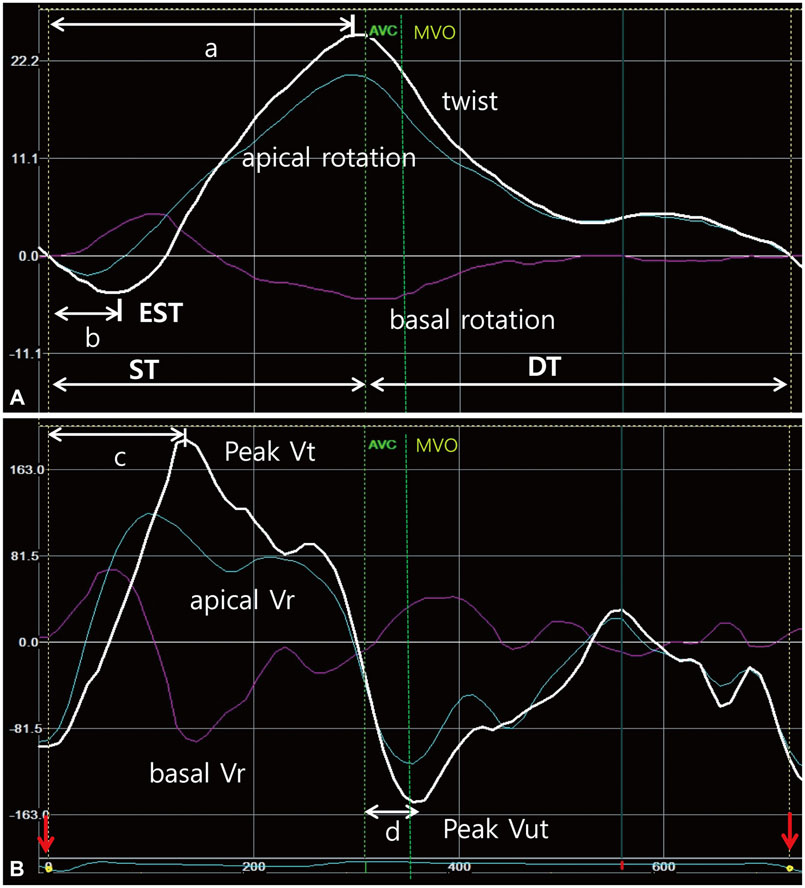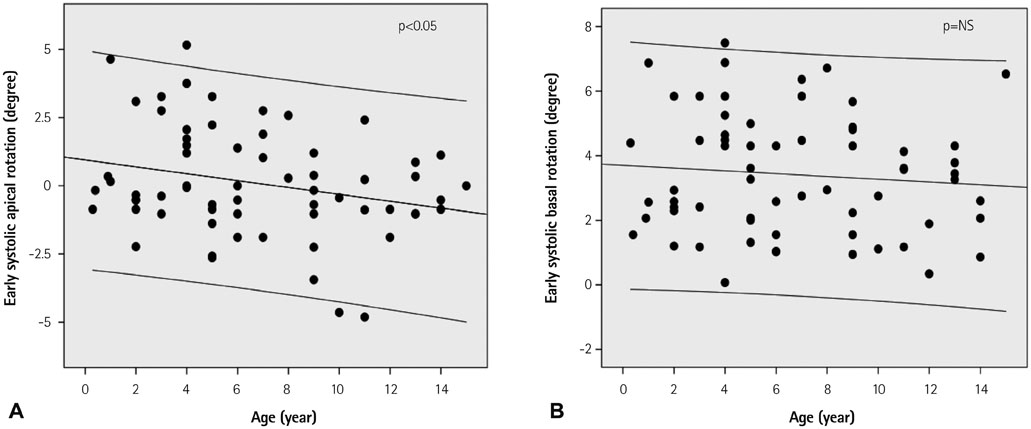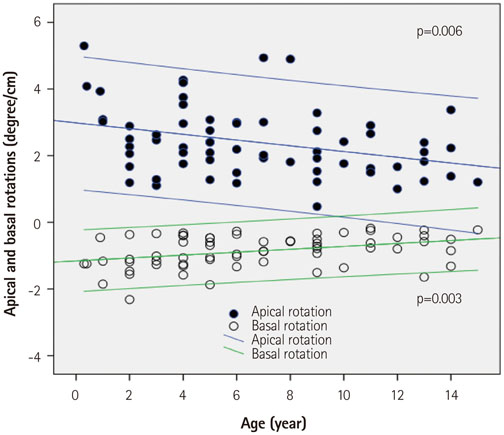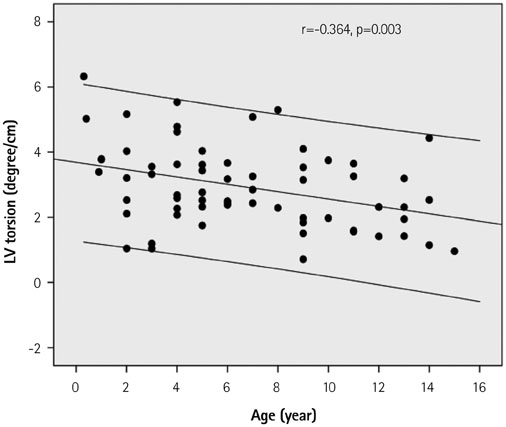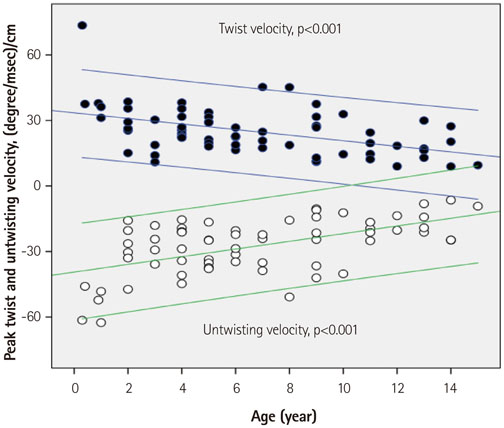Korean Circ J.
2015 Mar;45(2):131-140. 10.4070/kcj.2015.45.2.131.
Normal Left Ventricular Torsion Mechanics in Healthy Children: Age Related Changes of Torsion Parameters Are Closely Related to Changes in Heart Rate
- Affiliations
-
- 1Department of Pediatrics, College of Medicine, The Catholic University of Korea, Seoul, Korea. jaeyounglee@catholic.ac.kr
- KMID: 2297880
- DOI: http://doi.org/10.4070/kcj.2015.45.2.131
Abstract
- BACKGROUND AND OBJECTIVES
This study was aimed at assessing left ventricular torsion (LVtor) mechanics using speckle tracking echocardiography (STE), establishing normal reference values of principal LVtor parameters, and analyzing the age-related changes in normal children.
SUBJECTS AND METHODS
Eighty children (aged 3 months to 15 years) with normal cardiac function and rhythm were recruited. LVtor parameters including rotations, twist and untwist, torsion, and their rate indices were measured using STE. Age and heart rate related changes of the parameters were analyzed.
RESULTS
Speckle tracking echocardiography analyses for LVtor parameters had excellent reliability in 64 of 80 subjects (80%) (intraclass correlation coefficients; 0.93-0.97). Early systolic twist (EST) motions (-8.4--0.1degrees) were observed in all subjects during an early 20+/-7% of systolic time intervals. The peak systolic twist and torsion were 17.0+/-6.5degrees and 2.9+/-1.3degrees/cm, respectively. The peak twist velocity was recorded at 51+/-13% of systolic time and the peak untwist velocity at 13.8+/-11.5% of diastolic time intervals. Multivariate analysis showed that heart rate change was an independent predictor of changes in torsion parameters; significantly decreasing LV length-normalized apical and basal rotation, torsion, and twist and untwist rate with increasing age. Isovolumetric recoil rate was independent of change in age and heart rate.
CONCLUSION
Left ventricle showed unique torsion mechanics in children with EST, torsion, and untwists. Heart rate was an independent predictor of the change in torsion parameters with aging.
MeSH Terms
Figure
Reference
-
1. Sengupta PP, Korinek J, Belohlavek M, et al. Left ventricular structure and function: basic science for cardiac imaging. J Am Coll Cardiol. 2006; 48:1988–2001.2. Sengupta PP, Tajik AJ, Chandrasekaran K, Khandheria BK. Twist mechanics of the left ventricle: principles and application. JACC Cardiovasc Imaging. 2008; 1:366–376.3. Nielsen PM, Le Grice IJ, Smaill BH, Hunter PJ. Mathematical model of geometry and fibrous structure of the heart. Am J Physiol. 1991; 260(4 Pt 2):H1365–H1378.4. Vendelin M, Bovendeerd PH, Engelbrecht J, Arts T. Optimizing ventricular fibers: uniform strain or stress, but not ATP consumption, leads to high efficiency. Am J Physiol Heart Circ Physiol. 2002; 283:H1072–H1081.5. Young AA, Cowan BR. Evaluation of left ventricular torsion by cardiovascular magnetic resonance. J Cardiovasc Magn Reson. 2012; 14:49.6. Notomi Y, Setser RM, Shiota T, et al. Assessment of left ventricular torsional deformation by Doppler tissue imaging: validation study with tagged magnetic resonance imaging. Circulation. 2005; 111:1141–1147.7. Notomi Y, Srinath G, Shiota T, et al. Maturational and adaptive modulation of left ventricular torsional biomechanics: Doppler tissue imaging observation from infancy to adulthood. Circulation. 2006; 113:2534–2541.8. Helle-Valle T, Crosby J, Edvardsen T, et al. New noninvasive method for assessment of left ventricular rotation: speckle tracking echocardiography. Circulation. 2005; 112:3149–3156.9. Amundsen BH, Helle-Valle T, Edvardsen T, et al. Noninvasive myocardial strain measurement by speckle tracking echocardiography: validation against sonomicrometry and tagged magnetic resonance imaging. J Am Coll Cardiol. 2006; 47:789–793.10. Urbano Moral JA, Arias Godinez JA, Maron MS, et al. Left ventricular twist mechanics in hypertrophic cardiomyopathy assessed by three-dimensional speckle tracking echocardiography. Am J Cardiol. 2011; 108:1788–1795.11. Leitman M, Lysyansky P, Sidenko S, et al. Two-dimensional strain-a novel software for real-time quantitative echocardiographic assessment of myocardial function. J Am Soc Echocardiogr. 2004; 17:1021–1029.12. Blessberger H, Binder T. NON-invasive imaging: two dimensional speckle tracking echocardiography: basic principles. Heart. 2010; 96:716–722.13. Takahashi K, Al Naami G, Thompson R, Inage A, Mackie AS, Smallhorn JF. Normal rotational, torsion and untwisting data in children, adolescents and young adults. J Am Soc Echocardiogr. 2010; 23:286–293.14. Al-Naami GH. Torsion of young hearts: a speckle tracking study of normal infants, children, and adolescents. Eur J Echocardiogr. 2010; 11:853–862.15. Zhang Y, Zhou QC, Pu DR, Zou L, Tan Y. Differences in left ventricular twist related to age: speckle tracking echocardiographic data for healthy volunteers from neonate to age 70 years. Echocardiography. 2010; 27:1205–1210.16. Kaku K, Takeuchi M, Tsang W, et al. Age-related normal range of left ventricular strain and torsion using three-dimensional speckle-tracking echocardiography. J Am Soc Echocardiogr. 2014; 27:55–64.17. Kim HK, Sohn DW, Lee SE, et al. Assessment of left ventricular rotation and torsion with two-dimensional speckle tracking echocardiography. J Am Soc Echocardiogr. 2007; 20:45–53.18. Takeuchi M, Nakai H, Kokumai M, Nishikage T, Otani S, Lang RM. Age-related changes in left ventricular twist assessed by two-dimensional speckle-tracking imaging. J Am Soc Echocardiogr. 2006; 19:1077–1084.19. van Dalen BM, Soliman OI, Vletter WB, ten Cate FJ, Geleijnse ML. Age-related changes in the biomechanics of left ventricular twist measured by speckle tracking echocardiography. Am J Physiol Heart Circ Physiol. 2008; 295:H1705–H1711.20. Sengupta PP, Khandheria BK, Korinek J, Wang J, Belohlavek M. Biphasic tissue Doppler waveforms during isovolumic phases are associated with asynchronous deformation of subendocardial and subepicardial layers. J Appl Physiol (1985). 2005; 99:1104–1111.21. Ashikaga H, Coppola BA, Hopenfeld B, Leifer ES, McVeigh ER, Omens JH. Transmural dispersion of myofiber mechanics: implications for electrical heterogeneity in vivo. J Am Coll Cardiol. 2007; 49:909–916.22. Taber LA, Yang M, Podszus WW. Mechanics of ventricular torsion. J Biomech. 1996; 29:745–752.23. Beyar R, Yin FC, Hausknecht M, Weisfeldt ML, Kass DA. Dependence of left ventricular twist-radial shortening relations on cardiac cycle phase. Am J Physiol. 1989; 257(4 Pt 2):H1119–H1126.24. Parisi V, Losi MA, Contaldi C, et al. Speckle-tracking analysis based on 2D echocardiography does not reliably measure left ventricular torsion. Clin Physiol Funct Imaging. 2013; 33:117–121.25. Dong SJ, Hees PS, Siu CO, Weiss JL, Shapiro EP. MRI assessment of LV relaxation by untwisting rate: a new isovolumic phase measure of tau. Am J Physiol Heart Circ Physiol. 2001; 281:H2002–H2009.26. Cheung YF, Li SN, Chan GC, Wong SJ, Ha SY. Left ventricular twisting and untwisting motion in childhood cancer survivors. Echocardiography. 2011; 28:738–745.27. Forsey J, Benson L, Rozenblyum E, Friedberg MK, Mertens L. Early changes in apical rotation in genotype positive children with hypertrophic cardiomyopathy mutations without hypertrophic changes on two-dimensional imaging. J Am Soc Echocardiogr. 2014; 27:215–221.28. Khoo NS, Smallhorn JF, Atallah J, Kaneko S, Mackie AS, Paterson I. Altered left ventricular tissue velocities, deformation and twist in children and young adults with acute myocarditis and normal ejection fraction. J Am Soc Echocardiogr. 2012; 25:294–303.
- Full Text Links
- Actions
-
Cited
- CITED
-
- Close
- Share
- Similar articles
-
- Left Ventricular Rotation and Twist: Why Should We Learn?
- Clinical observation on torsion of the testis
- Myocardial Rotation and Torsion in Child Growth
- Age-Related Changes in Left Ventricular Torsion as Assessed by 2-Dimensional Ultrasound Speckle Tracking Imaging
- Age and Gender Specific Reference Value of Ocular Torsion by Using Funduscope in Korean

